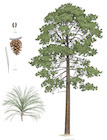
Illustration of tree, foliage, cone, and seeds [Matt Strieby, 2023].
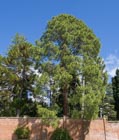
Large tree (ca. 30 m tall, 100 cm dbh) at the Royal Botanical Garden Hobart, Tasmania [C.J. Earle, 2015.03.09].
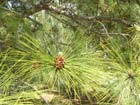
Foliage, including new growth and old pollen cones, on a tree in Quail Botanical Garden, California [C.J. Earle, 2004.04.06].
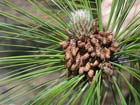
Detail of new growth and old pollen cones, on tree shown above [C.J. Earle, 2004.04.06].
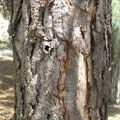
Bark on the tree shown above [C.J. Earle, 2004.04.06].
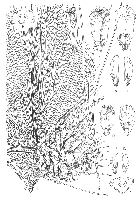
Line drawing; for full size image go to the Flora of China (Wu and Raven 1999).
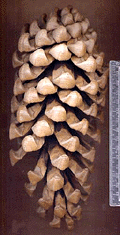
Link to photo in the Michael P. Frankis cone collection.
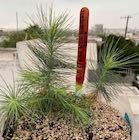
Recently germinated seedlings [Facebook post by Victor Hugo Garza Guajardo, 2020.03.15].

Pinus roxburghii
Sargent 1897
Common names
चीड chir [Hindi]; 西藏长叶松 xu mi chang ye song [Chinese]; ചരളം [Malay]; Khote sallo [Nepali]; Sarala [Sanskrit]; Chir pine, Imodi pine.
Taxonomic notes
Syn.: Pinus longifolia Roxb. ex Lamb. 1803 non Salisb. 1796 (Farjon 1998). This was a homonym, a situation corrected by Sargent in 1897 with a name honoring Scots botanist William Roxburgh for his description of the species.
A genetic study using nuclear and chloroplast microsatellite loci found very low differentiation between populations in Nepal, which the authors attributed to efficient long-distance gene flow (Gauli et al. 2009). I know of no rangewide studies of variation within the species.
Description
Trees to 55 m tall and over 100 cm dbh. Bark dark red-brown, thick, deeply and longitudinally fissured, scaly; winter buds brown, small, ovoid, not resinous. Leaves 3 per bundle, slender, flabellate-triangular in cross section, 20-30 cm × 1.5 mm, resin canals 2, median, base with persistent sheath 2-3 cm long. Seed cones shortly pedunculate, ovoid, 10-20 × 6-9 cm. Seed scales oblong, thick, stiff; apophyses strongly swollen, conspicuously transversely ridged; umbo triangular, protruding. Seeds 8-12 mm long; wing ca. 2.5 cm long. Seed maturity Oct-Nov (Wu and Raven 1999).
Distribution and Ecology
Himal: Bhutan; India: Jammu and Kashmir, Punjab, Himanchal Pradesh, Uttarakhand; Nepal; Pakistan; Sikkim; Afghasistan; S Tibet; in mountains at 450-2300 m elevation. Limited to the monsoon belt between 72°-95°E and 27°-35°N (Wu and Raven 1999, Arya et al. 2000). Within its range, it is not only a common species, but is also the most widely planted conifer, and comprises 17% of the forested area of Nepal (Gauli et al. 2009).
Zone 9 (cold hardiness limit between -6.6°C and -1.1°C) (Bannister and Neuner 2001).
Remarkable Specimens
The only tree for which I have seen a measurement is on ornamental specimen in Capitol Park, Sacramento, California which was 30.5 m tall and 149 cm dbh (100 feet tall and 184 inch girth) in 2007 (Arthur L. Jacobson e-mail 2007.08.24).
The oldest known living specimen, 326 years, was documented in a tree-ring chronology covering the period 1650-1979 (crossdated after 1668), collected in Nepal by R. Zuber, A. Bhattacharyya, and P. J. Krusic (doi.org/10.25921/8474-vh71).
Ethnobotany
The timber is used for construction, furniture, etc., and the trunk as a source of resin (Wu and Raven 1999).
The species has been used in dendrochronology. Exploratory work by Bhattacharyya et al. (1992) found that this species crossdates well and its growth is reasonably well correlated with climate. A few other studies have looked at wood anatomy and growth in relation to climate, but generally little work has been done.
Observations
No data as of 2023.11.03.
Remarks
The species comes closer than any other other pine to being deciduous, having a needle retention time of one year, the shortest of any pine (Richardson and Rundel 1998).
Roxburgh described this species from small specimens in ornamental gardens near Kolkata, India, reporting secondhand information on its occurrence in Nepal, "where they are found on the stupendous mountains, there growing to an immense size, and there they blossom about the beginning of the hot season" (Lambert 1803).
Citations
Arya, S., R.K. Kalia, and I.D. Arya. 2000. Induction of somatic embryogenesis in Pinus roxburghii Sarg. Plant Cell Reports 19(8):775-780.
Bhattacharyya, A., LaMarche, Jr., V.C., Hughes, M.K. 1992. Tree-ring chronologies from Nepal. Tree-Ring Bulletin 52:59-66.
Gauli, A., O. Gailing, V. M. Stefenon, and R. Finkeldey. 2009. Genetic similarity of natural populations and plantations of Pinus roxburghii Sarg. in Nepal. Annals of Forest Science 66:703-712.
Lambert, Aylmer Bourke. 1803. A Description of the Genus Pinus. London: J. White.
Sargent, C.S. 1897. The Silva of North America: a description of the trees which grow naturally in North America exclusive of Mexico. Vol. 11. Boston and New York.
See also








